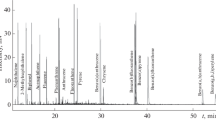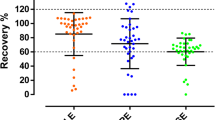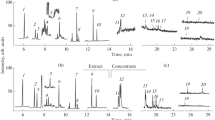Abstract
Chlorinated polycyclic aromatic hydrocarbons (ClPAHs), including polychlorinated naphthalenes (PCNs), are hazardous and widespread in the environment, but studies of these substances in the wastewater environment are lacking. In this study, five typical PCNs and five typical ClPAHs (other than PCNs) were simultaneously detected along with their parent polycyclic aromatic hydrocarbons in wastewater samples. All these compounds could be analyzed by gas chromatography– electron ionization mass spectrometry in selected ion monitoring mode and separated on a DB-17ms column. Calibration curves were created both in pure solvent and in wastewater matrix samples. The coefficients of determination for most compounds were greater than 0.99, indicating a satisfactory degree of linearity in the complex matrix samples. The influence of the matrix on the true concentrations of the environmental samples was corrected by use of the matrix calibration curve. The recoveries of all compounds were between 58% and 127%, with standard deviations lower than 20%. The method detection and quantification limits were less than 27.6 ng/L and less than 91.9 ng/L respectively in the aqueous phase, and less than 0.18 ng/L and less than 0.61 ng/L respectively in the solid phase of 4-L wastewater samples. This analytical method was successfully used to detect PCNs and ClPAHs in the water from a river receiving effluent from a wastewater treatment plant. The concentrations of each compound ranged from 3.1 to 29.6 ng/L. This method could also be used for detection of other polycyclic aromatic hydrocarbon derivatives with similar physical and chemical properties in different matrix samples.

ᅟ





Similar content being viewed by others
References
Ohura T. Environmental behavior, sources, and effects of chlorinated polycyclic aromatic hydrocarbons. Sci World J. 2007;7:372–80.
Espadaler I, Eljarrat E, Caixach J, Rivera J, Marti I, Ventura F. Assessment of polychlorinated naphthalenes in aquifer samples for drinking water purposes. Rapid Commun Mass Spectrom. 1997;11:410–4.
Wu M, Li G, Ma J, Xu G, Guo R. Research progress on new type organic contaminants-chlorinated polycyclic aromatic hydrocarbons. Chin J Nat. 2010;32:217–23.
Bhatia AL, Tausch H, Stehlik G. Mutagenicity of chlorinated polycyclic aromatic compounds. Ecotoxicol Environ Saf. 1987;14:48–55.
Pinto M, Rebola M, Louro H, et al. Chlorinated polycyclic aromatic hydrocarbons associated with drinking water disinfection: synthesis, formation under aqueous chlorination conditions and genotoxic effects. Polycycl Aromat Compd. 2014;34:356–71.
Johnsen S, Gribbestad IS, Johansen S. Formation of chlorinated PAH - a possible health hazard from water chlorination. Sci Total Environ. 1989;81:231–8.
Eljarrat E, Caixach J, Jimenez B, Gonzalez MJ, Rivera J. Polychlorinated naphthalenes in sediments from the Venice and Orbetello lagoons, Italy. Chemosphere. 1999;38:1901–12.
Pizzini S, Piazza R, Cozzi G, Barbante C. Simultaneous determination of halogenated contaminants and polycyclic aromatic hydrocarbons: a multi-analyte method applied to filter-feeding edible organisms. Anal Bioanal Chem. 2016;408:7991–9.
Li F, Jin J, Tan D, et al. High performance solid-phase extraction cleanup method coupled with gas chromatography-triple quadrupole mass spectrometry for analysis of polychlorinated naphthalenes and dioxin-like polychlorinated biphenyls in complex samples. J Chromatogr A. 2016;1448:1–8.
Mahmood A, Malik RN, Li J, Zhang G. Congener specific analysis, spatial distribution and screening-level risk assessment of polychlorinated naphthalenes in water and sediments from two tributaries of the River Chenab, Pakistan. Sci Total Environ. 2014;485:693–700.
Kannan K, Imagawa T, Blankenship AL, Giesy JP. Isomer-specific analysis and toxic evaluation of polychlorinated naphthalenes in soil, sediment, and biota collected near the site of a former chlor-alkali plant. Environ Sci Technol. 1998;32:2507–14.
Shiraishi H, Pilkington NH, Otsuki A, Fuwa K. Occurrence of chlorinated polynuclear aromatic hydrocarbons in tap water. Environ Sci Technol. 1985;19:585–90.
Gao ZY, Jiang WS, Sun D, et al. Chlorination for efficient identification of polycyclic aromatic hydrocarbons by liquid chromatography-mass spectrometry. Talanta. 2010;81:48–54.
Oyler AR, Liukkonen RJ, Lukasewycz MK, Cox DA, Peake DA, Carlson RM. Implications of treating water containing polynuclear aromatic hydrocarbons with chlorine - a gas chromatographic-mass spectrometric study. Environ Health Perspect. 1982;46:73–86.
Oyler AR, Liukkonen RJ, Lukasewycz MT, Heikkila KE, Cox DA, Carlson RM. Chlorine disinfection chemistry of aromatic compounds. polynuclear aromatic hydrocarbons: rates, products, and mechanisms. Environ Sci Technol. 1983;17:334–42.
Nilsson UL, Ostman CE. Chlorinated polycyclic aromatic hydrocarbons - method of analysis and their occurrence in urban air. Environ Sci Technol. 1993;27:1826–31.
Tillner J, Hollard C, Bach C, Rosin C, Munoz JF, Dauchy X. Simultaneous determination of polycyclic aromatic hydrocarbons and their chlorination by-products in drinking water and the coatings of water pipes by automated solid-phase microextraction followed by gas chromatography-mass spectrometry. J Chromatogr A. 2013;1315:36–46.
Ma J, Horii Y, Cheng JP, et al. Chlorinated and parent polycyclic aromatic hydrocarbons in environmental samples from an electronic waste recycling facility and a chemical industrial complex in China. Environ Sci Technol. 2009;43:643–9.
Ishaq R, Naf C, Zebuhr Y, Broman D, Jarnberg U. PCBs, PCNs, PCDD/Fs, PAHs and Cl-PAHs in air and water particulate samples - patterns and variations. Chemosphere. 2003;50:1131–50.
Qiao M, Qi WX, Liu HJ, Qu JH. Simultaneous determination of typical substituted and parent polycyclic aromatic hydrocarbons in water and solid matrix by gas chromatography-mass spectrometry. J Chromatogr A. 2013;1291:129–36.
Marti I, Ventura F. Polychlorinated naphthalenes in groundwater samples from the Llobregat aquifer (Spain). J Chromatogr A. 1997;786:135–44.
Vinzelberg G, Schwarzbauer J, Littke R. Groundwater contamination by chlorinated naphthalenes and related substances caused by activities of a former military base. Chemosphere. 2005;61:770–82.
Helm PA, Jantunen LM, Ridal J, Bidleman TF. Spatial distribution of polychlorinated naphthalenes in air over the great lakes and air-water gas exchange in Lake Ontario. Environ Toxicol Chem. 2003;22:1937–44.
Environment Canada. Ecological screening assessment. Polychlorinated naphthalenes. 2011. https://www.ec.gc.ca/ese-ees/835522FE-AE6C-405A-A729-7BC4B7C794BF/CNs_SAR_En.pdf.
Vallecillos L, Pocurull E, Borrull F. Influence of pre-treatment process on matrix effect for the determination of musk fragrances in fish and mussel. Talanta. 2015;134:690–8.
Acknowledgements
This work was supported by National Natural Science Foundation of China (grant nos 51508552, 51420105012) and the Key Research Program of the Chinese Academy of Sciences (grant no. ZDRW-ZS-2016-5-6).
Publisher’s Note
Springer Nature remains neutral with regard to jurisdictional claims in published maps and institutional affiliations.
Author information
Authors and Affiliations
Corresponding author
Ethics declarations
Conflict of interest
The authors declare that they have no conflict of interest.
Electronic supplementary material
Below is the link to the electronic supplementary material.
ESM 1
(PDF 101 kb)
Rights and permissions
About this article
Cite this article
Qiao, M., Cao, W., Liu, B. et al. Simultaneous detection of chlorinated polycyclic aromatic hydrocarbons with polycyclic aromatic hydrocarbons by gas chromatography–mass spectrometry. Anal Bioanal Chem 409, 3465–3473 (2017). https://doi.org/10.1007/s00216-017-0290-1
Received:
Revised:
Accepted:
Published:
Issue Date:
DOI: https://doi.org/10.1007/s00216-017-0290-1




